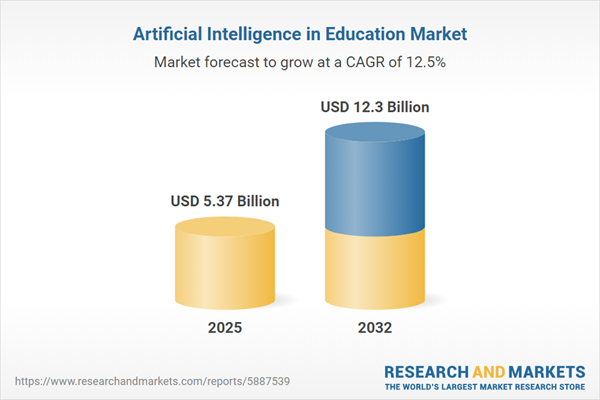Speak directly to the analyst to clarify any post sales queries you may have.
The artificial intelligence in education market is undergoing rapid transformation, presenting new opportunities and considerations for institutional leaders, technology providers, and training organizations. With the dynamic convergence of adaptive platforms, automation, and data analytics, senior decision-makers are seeking clear strategies to maximize outcomes from AI investments in diverse educational environments.
Market Snapshot: Artificial Intelligence in Education Market
The Artificial Intelligence in Education Market grew from USD 4.80 billion in 2024 to USD 5.37 billion in 2025. It is expected to continue growing at a CAGR of 12.47%, reaching USD 12.30 billion by 2032. Advancements in adaptive learning, machine vision, natural language processing, and predictive analytics are driving the adoption of AI across schools, universities, corporate training providers, and vocational programs. AI-enabled learning platforms, automated feedback tools, and data-centric instruction now form integral components of mainstream educational strategy, fundamentally altering how curricula are developed, learning is measured, and personalized experiences are scaled.
Scope & Segmentation
- Learning Format: Group learning, personalized learning.
- Technology Type: Computer vision, machine learning, natural language processing.
- Type: Administrative systems, instructional systems.
- Implementation: Cloud-based (hybrid, private, and public), on-premises solutions.
- Application Area: Corporate training (leadership, professional development, technical skills), higher education (doctoral, postgraduate, undergraduate), K-12 education (primary, secondary), vocational training (technical and trade courses).
- Regional Coverage: Americas (United States, Canada, Mexico, Brazil, Argentina, Chile, Colombia, Peru), Europe, Middle East & Africa (United Kingdom, Germany, France, Russia, Italy, Spain, Netherlands, Sweden, Poland, Switzerland, UAE, Saudi Arabia, Qatar, Turkey, Israel, South Africa, Nigeria, Egypt, Kenya), Asia-Pacific (China, India, Japan, Australia, South Korea, Indonesia, Thailand, Malaysia, Singapore, Taiwan).
- Company Analysis: Major organizations include 2U, Inc., Academia.edu, Inc., Amazon Web Services, Inc., AstrumU Inc., Blackboard Inc. by Anthology, Brilliant.org, Inc., Carnegie Learning, Inc., Century Tech Limited, Cognii, Inc., Cognizant Technology Solutions Corporation, Coursera, Inc., Duolingo, Inc., Google LLC by Alphabet Inc., IBM Corporation, John Wiley & Sons, Inc., McGraw-Hill Education, Inc., Microsoft Corporation, OCELOT, Pearson Plc, Querium Corporation, Quizlet Inc., SMART Technologies ULC, Thinkster Learning, Inc., Udacity, Inc. by Accenture public limited company, YiXue Squirrel AI Learning Inc.
Key Takeaways
- AI is transitioning from pilot programs to core instructional frameworks, enabling real-time adaptation of content and dynamic student engagement.
- Intelligent tutoring, automated grading, and machine vision solutions free educators from repetitive tasks and drive greater personalization.
- The shift towards cloud-based and hybrid deployment models enhances infrastructure scalability and data sovereignty options for organizations of every size.
- Segment adoption varies: corporations pursue rapid skills upgrades through microlearning, universities utilize analytics for research, while K-12 emphasizes adaptive diagnostics and vocational institutes integrate immersive simulations.
- Regional variations shape AI integration priorities, from policy-driven compliance in EMEA to mobile-first deployment in Asia-Pacific and cross-sector partnerships in the Americas.
- Competitive differentiation is influenced by proprietary algorithms, cybersecurity, interoperability, and the ability to form strategic partnerships or enter new regions through M&A activity.
Tariff Impact: United States 2025 Adjustments
Recent U.S. tariff policies on AI hardware and components have increased procurement costs for educational technology tools, influencing vendor supply chains and budget strategies. Vendors are exploring alternative supply sources, adjusting software licensing, and favoring subscription and cloud models. Institutions respond by extending hardware life cycles, pooling resources via consortia, and prioritizing software-driven improvements to manage costs effectively without sacrificing innovation.
Methodology & Data Sources
This report uses a rigorous multi-phase methodology, combining primary interviews with educational leaders, technology executives, and policymakers alongside in-depth secondary reviews of industry studies, regulatory guidelines, and scholarly research. Data triangulation and segmentation frameworks support regional and vertical analysis, while market trends were validated through expert panels and provider profiling to ensure credible, actionable insights.
Why This Report Matters
- Gain a holistic understanding of the artificial intelligence in education market landscape, segmented by learning formats, deployment models, technologies, and regional dynamics.
- Equip your organization to make informed, future-proof investments by tracking the influence of regulatory, technological, and supply chain factors across global education ecosystems.
- Identify strategic partnership, expansion, and vendor selection opportunities to support long-term organizational goals amid evolving AI capabilities.
Conclusion
Leveraging data-driven approaches and adaptive platforms is increasingly central to effective educational leadership. This report equips decision-makers with clear market understanding and strategic insights to drive sustainable AI adoption and competitive positioning in a changing educational landscape.
Additional Product Information:
- Purchase of this report includes 1 year online access with quarterly updates.
- This report can be updated on request. Please contact our Customer Experience team using the Ask a Question widget on our website.
Table of Contents
3. Executive Summary
4. Market Overview
7. Cumulative Impact of Artificial Intelligence 2025
Companies Mentioned
The companies profiled in this Artificial Intelligence in Education market report include:- 2U, Inc.
- Academia.edu, Inc.
- Amazon Web Services, Inc.
- AstrumU Inc.
- Blackboard Inc. by Anthology
- Brilliant.org, Inc.
- Carnegie Learning, Inc.
- Century Tech Limited
- Cognii, Inc.
- Cognizant Technology Solutions Corporation
- Coursera, Inc.
- Duolingo, Inc.
- Google LLC by Alphabet Inc.
- IBM Corporation
- John Wiley & Sons, Inc.
- McGraw-Hill Education, Inc.
- Microsoft Corporation
- OCELOT
- Pearson Plc
- Querium Corporation
- Quizlet Inc.
- SMART Technologies ULC
- Thinkster Learning, Inc.
- Udacity, Inc. by Accenture public limited company
- YiXue Squirrel AI Learning Inc.
Table Information
| Report Attribute | Details |
|---|---|
| No. of Pages | 188 |
| Published | November 2025 |
| Forecast Period | 2025 - 2032 |
| Estimated Market Value ( USD | $ 5.37 Billion |
| Forecasted Market Value ( USD | $ 12.3 Billion |
| Compound Annual Growth Rate | 12.4% |
| Regions Covered | Global |
| No. of Companies Mentioned | 26 |









